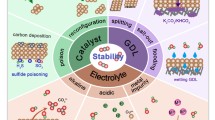Abstract
THE reduction of gaseous oxides such as CO2 and H2O is an important concern in industrial processes and pollution control. Here we report the reduction of carbon dioxide to carbon with an efficiency of nearly 100% at 290 °C using cation-excess magnetite (Fe3+δO4, δ =0.127). In this reaction, the oxygen in the CO2 is transferred, in the form of O2−, to the cation-excess magnetite, and no gas is evolved. The carbon in the CO2 is reduced to carbon (zero valence) by the addition of an electron donated from the cation-excess magnetite to maintain electrical neutrality during the transfer of the O2− to the magnetite. When we used H2O in place of CO2, hydrogen gas was evolved, indicating that the same mechanism can also reduce H2O.
Similar content being viewed by others
References
Smith, J. & Wijin, J. I. J. Ferrite, 136 (Philips Technical Library, Tokyo, 1965).
Kiyama, M. Bull. chem. Soc. Japan 47, 1646–1650 (1974).
Katsura, T. & Tamaura, Y. Bull. chem. Soc. Japan 52, 96–100 (1979).
Annersten, H. & Hafner, S. S. Z. Kristallogr. 137, 321–340 (1973).
Volenik, K., Seberiai, M. & Neid, J. Czech. J. Phys. B25, 1063–1071 (1975).
Topsøe, H., Dumesic, J. A. & Boudart, M. J. Phys., Paris C6, 411–413 (1974).
JCPDS card 19-629 (Joint Committee on Powder Diffraction Standards, Swarthmore, 1989).
Dieckmann, R. Ber. Bunsenges, phys. Chem. 86, 112–118 (1982).
Dieckmann, R. & Schmalzried, H. Ber. Bunsenges. phys. Chem. 81, 414–419 (1977).
Darken, L. S. & Gurry, R. W. J. Am. chem. Soc. 67, 1398–1412 (1945).
Darken, L. S. & Gurry, R. W. J. Am. chem. Soc. 68, 798–816 (1945).
Copperthwaite, R. G., Davies, P. R., Morris, M. A., Roberts, M. W. & Ryder, R. A. Catal. Lett. 1, 11–19 (1988).
Manning, M. P. & Reid, R. C. ASME Pap. 75-ENAS-22 (Am. Soc. mech. Engineers, 1975).
Wagner, R. C., Carrasquillo, R., Edwards, J. & Holmes, R. 18th Intersoc. Conf. Environmental Systems, SAE Tech. Pap. Ser. 880995, 1–9 (Soc. Automotive Engineers, 1988).
Iwasaki, I. et al. Bull. volc. Soc. Japan, Ser. II 5, 9–24 (1960).
Author information
Authors and Affiliations
Rights and permissions
About this article
Cite this article
Tamaura, Y., Tahata, M. Complete reduction of carbon dioxide to carbon using cation-excess magnetite. Nature 346, 255–256 (1990). https://doi.org/10.1038/346255a0
Received:
Accepted:
Issue Date:
DOI: https://doi.org/10.1038/346255a0
- Springer Nature Limited
This article is cited by
-
Stainless steel anisotropic superhydrophobic surfaces fabrication with inclined cone array via laser ablation and post annealing treatment
Journal of Central South University (2022)
-
Selective reduction of carbon dioxide into amorphous carbon over activated natural magnetite
International Journal of Minerals, Metallurgy and Materials (2021)
-
Magnetic Nanoparticles Impregnated, Cross-Linked, Porous Chitosan Microspheres for Efficient Adsorption of Methylene Blue from Pharmaceutical Waste Water
Journal of Polymers and the Environment (2019)
-
New insights about the formation of copper ferrite: in situ X-ray diffraction study
Bulletin of the National Research Centre (2018)
-
3DOM-NiFe2O4 as an effective catalyst for turning CO2 and H2O into fuel (CH4)
Journal of Sol-Gel Science and Technology (2018)





